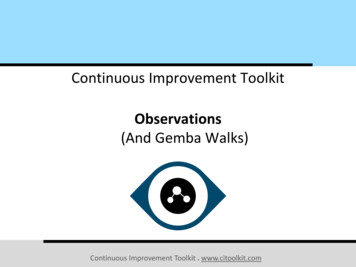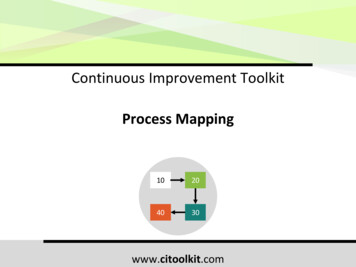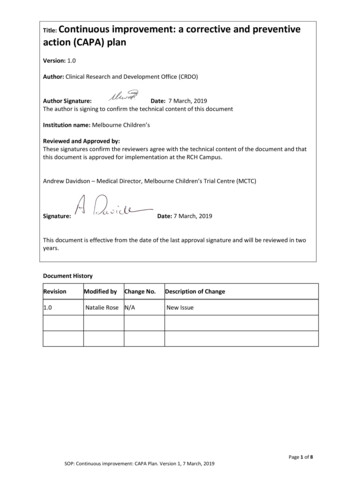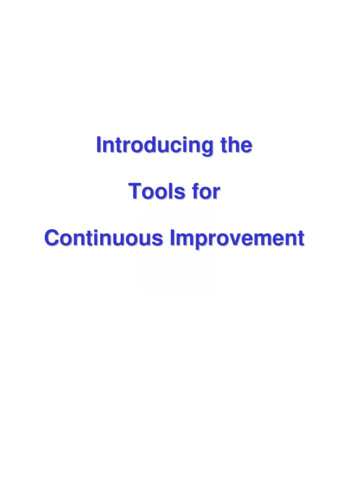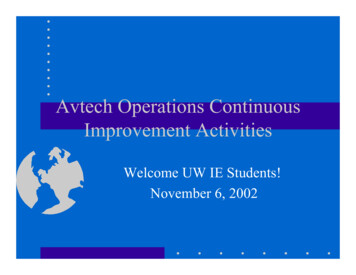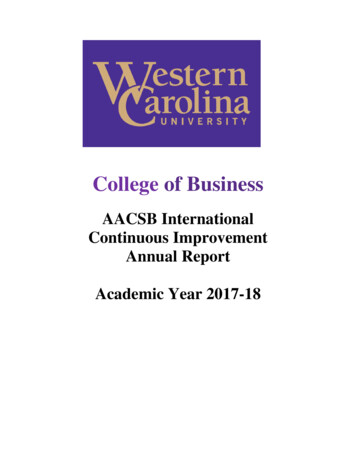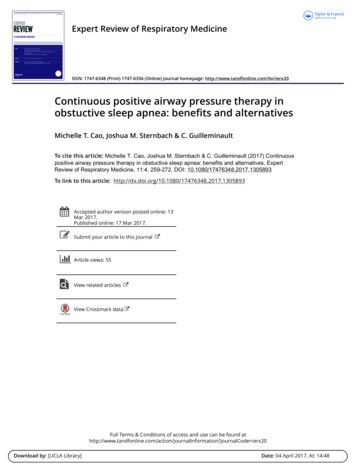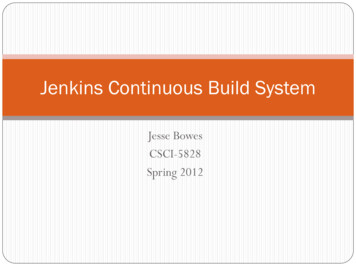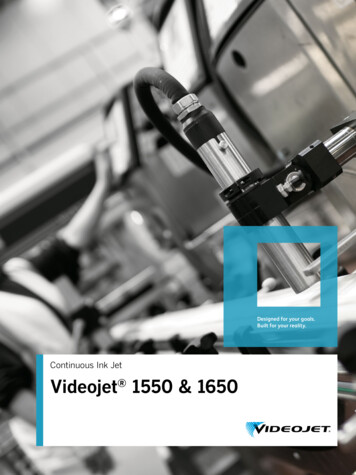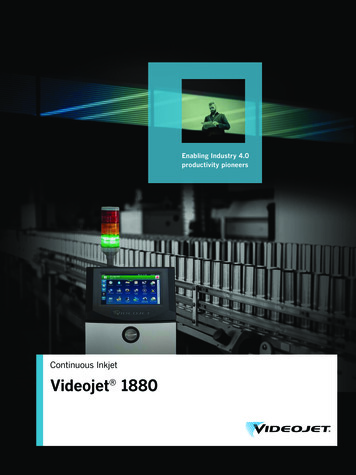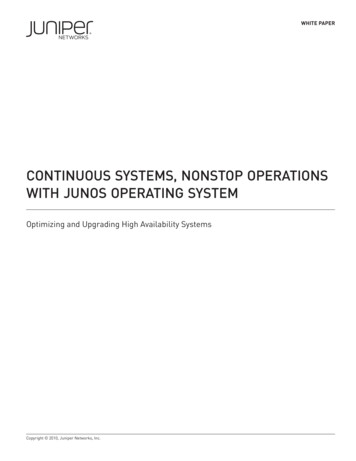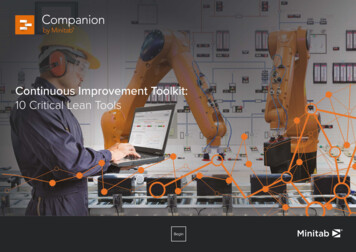
Transcription
Continuous Improvement Toolkit:10 Critical Lean ToolsBegin
Continuous Improvement Toolkit: 10 Critical Lean ToolsIntroduction to Lean ToolsCompanion by MinitabDashboardAlthough Lean uses data, its tools are not as analytical or data-rich as those used in Six Sigma in manufacturing.For example, Lean tools are more about understanding the process, looking for waste, preventing mistakes,and documenting what you did. Lean seeks to make it easy to do things the right way and hard to do things thewrong way.There are many examples of the positive impact of Lean implementation in just about every industry and typeof organization. Dramatic cost savings, lead time and inventory reductions as well as many other improvementshave been cited by businesses around the world. Familiarising yourself with Lean tools is a great way to getstarted in implementing Lean.In this toolkit, we briefly explain the key Lean tools used in process improvement, what they do, and whythey’re important. The tools we selected for this toolkit are straightforward, but they are incredibly powerfulwhen it comes to identifying and eliminating waste and defects.How can you use and apply these Lean tools yourself? One approach is to use Companion by Minitab, thesoftware we’ve developed to manage Continuous Improvement projects end-to-end. Companion combines adesktop toolkit of Lean and quality tools for executing your projects with a web-based dashboard for visualisingbenefits and project information. Using a workflow, the software will manage the flow of ideas to projects tocompletion, effortlessly streamlining phase reviews and approvals.Learning to use Lean tools is a must for any continuous improvement practitioner. If you want to try them foryourself and you haven’t looked at the Companion software yet, we encourage you to download a free30-day trial.ProjectsCI DeploymentActionsVIEWING DATA FOR: All Projectsrestore defaultsActual Combined Savings YTD“Lean” focuses on maximising customer value by removing waste and eliminating defects. Lean is a mindsetthat everyone in an organisation should be able to spot waste and bring it up to Management to be addressed.Workflow3.48 MActual Hard Savings YTD0MTARGET 2.50 M 982 k( 39.3%)Projects Started Last 4 QuartersThis YearActual Soft Savings YTD1M2M0M1.42 M2.06 MTARGET 1.50 M-75.8 k(-5.1%)TARGET 1.00 M 1.06 M( 105.8%)1M2M3MTotal Actual Combined SavingsThis Year0M1M2M3M4M5M6M7M8M9M10M1 (33.3%)Number of ProjectsAll Time2 (66.7 %)Yes1247NoProjectsCOLUMN SETSProjects at a GlanceProject NameStatusStartedOn-time Order DeliveryOn Hold7/1/2017Paper ManagementIn Progress7/1/2017Reduce Scrap on Paper Line 1In Progress7/1/2017Reduce Scrap on Paper Line 2Not StartedRepackaging ProductsNot StartedCurrent PhaseCompletedHealthReplicable?Best Practice?MethodoDMAICD M A I C7/19/2017DMAICDMAIC1Total Rows: 5Free TrialShow on page:10
Continuous Improvement Toolkit: 10 Critical Lean ToolsExampleNow let’s explore ten critical Lean tools used in process improvements, what they do, and why they’re important.To start leveraging these tools and other continuous improvement methods in your business, remember to trythem out in Companion by Minitab. These tools are even more powerful if you can share and collaborate withyour team, so we encourage you to try Companion’s online dashboard reporting capabilities as well.Lean Tool #1.Voice of the Customer (VOC) SummaryWhy it matters: A basic tenet of Lean is to understand the customer needs and design the process to fully meetor exceed customer expectations. When implementing Lean, it is fundamental to capture the voice, expectations,preferences and comments of the customer regarding your product or service. The Voice of the Customer (VOC)forms the foundation against which all improvements are judged.How to use it: The VOC Summary tool provides a way to capture this vital data. Using the VOC Summary tool willhelp you understand the key customer issues, convert them into critical customer requirements, and meet keybusiness and customer relationship goals.Key IssuesVoice of the CustomerKey RequirementsVOC ToolMeet business and customerrelationship goals30 Day Free TrialHere is the VOC Summary tool in Companion, which is held as anintegral part of a Continuous Improvement project or programme andused to guide decisions.
Continuous Improvement Toolkit: 10 Critical Lean ToolsExampleHere is a video demonstrating process maps and how they are used in Companion.Lean Tool #2.Process FlowWhy it matters: To improve a process, you must be able to understandand communicate the activities, or steps, in a process. You also need tosee the relationship between inputs and outputs, identify key decisionpoints and uncover backtracking, duplication or rework.How to use it: Process flows, also known as process maps, make iteasy to visualise a process. It is best to build process maps with theteam working in the process. The creation of a process flow makeswaste visible – e.g. bottlenecks, delays, storage, rework - and showsyou the best opportunities for improvement.Watch Video30 Day Free Trial
Continuous Improvement Toolkit: 10 Critical Lean ToolsExampleLean Tool #3.Value Stream Maps (VSM)Here is a video demonstrating the creation and use of value stream maps in Companion.Why it matters: The next step after process mapping is to understandwhere value is created or lost. Value is defined by the customer basedon their perception of the usefulness and necessity of a product orservice. In other words, value is what the customer is buying.How to use it: A value stream map is a collection of all the activities,both value-added and non-value added, that take a product or servicefrom its beginning through to the customer. You can include materialand information flow, operating parameters, or defect rates, lead times,and so on. This enables you to analyse the current state and design afuture state for the end-to-end activities that generate your product orservice to meet customer needs.Watch Video30 Day Free Trial
Continuous Improvement Toolkit: 10 Critical Lean ToolsExampleHere is the Five Whys tool in use in Companion, which provides aframework to link the project to the root cause of a problem.Lean Tool #4.Five WhysWhy it matters: Lean is about understanding why things are done the way they are. Often, thingsare done improperly, at the wrong time, or skipped altogether resulting in process problems.The challenge is to identify the root cause: most of the time it is the process that fails, not thepeople.How to use it: The Five Whys tool helps you to drill down and determine the root cause of aproblem. As the name implies, you repeat the question “Why?” five times. This helps you touncover the problem’s root cause, the relationships between different root causes, and identifysteps to prevent the problem from happening again. The real root cause typically points to aprocess that does not work well or does not exist.The problemWhy No.1Why No.2Why No.3The root cause30 Day Free TrialWhy No.4Why No.5
Continuous Improvement Toolkit: 10 Critical Lean ToolsExampleHere is 5S Audit tool in Companion which provides a consistentframework for sustaining the 5S gains. This tool also feeds the onlinedashboard reporting to ensure everyone’s progress is clear, visible andshareable.Lean Tool #5.5S Audit: Sort, Set in Order, Shine,Standardise and SustainWhy it matters: A clean, well-ordered workplace improves efficiency and eliminates waste. With amethod to organise, audit and maintain your workplaces and systems, you encourage productivityand ensure consistency across the business.How to use it: 5S is a team-based set of tools that systematically and methodically organise theworkplace. It comprises five steps to follow: Sort, Set in Order, Shine, Standardise and Sustain. Withthe first step, Sort, you remove the unwanted and unnecessary. With Set in Order, you arrange itemsto be easy to use. With Shine, you clean and inspect the workplace regularly. With Standardise, youestablish procedures and schedules to ensure the first 3 steps are consistently performed acrossyour organisation.The fifth and final step, Sustain, is one of the hardest steps to accomplish. It’s akin to losing theweight and keeping it off. Sustaining requires maintaining the gains of process improvements on aregular basis. Without it, old habits resurface, and the workplace falls into disarray. To support this, it’simportant that the benefits are visible and shared so everyone is encouraged to keep it up.Step 1SORT30 Day Free TrialStep 2SET IN ORDERStep 3SHINEStep 4STANDARDISEStep 5SUSTAIN
Continuous Improvement Toolkit: 10 Critical Lean ToolsExampleTo help leaders plan and implement a Kaizen event, Companionprovides a Roadmap to aid effective analysis, implementation, andenable reporting of results.Lean Tool #6.KaizenWhy it matters: Kaizen is a method for accelerating the pace ofprocess improvement projects. While originally developed formanufacturing, Kaizen is used extensively in a variety of industriesand is a valuable technique for the process improvement practitioner.Kaizen is most effective when used to eliminate waste and nonvalue-added activities.How to use it: Kaizen is a focused 3-5 day dedicated event to driveprocess improvements. Project objectives are well-defined andappropriately scoped going in to the Kaizen event. Employees arepulled from their daily duties to participate. Typically, there is a midweek review and a final presentation. Solutions are implementedimmediately.30 Day Free Trial
Continuous Improvement Toolkit: 10 Critical Lean ToolsLean Tool #7.Waste AnalysisExampleHere is the Waste Analysis by Operation tool in Companion, providing aclear view of areas to address.Why it matters: In Lean, waste is anything in a process thatis unnecessary and does not add value from the customer’sperspective. The purpose of Lean is to identify, analyse, andeliminate all sources of waste, such as defects or excessiveinventory.IdentifyAnalyseOptimised ProcessWasteHow to use it: Performing a Waste Analysis by Operationdocuments the types of waste at each process step, to quantifyand colour-code the degree of the waste. “No observed” wasteis a zero or a blank, while a 9 indicates “total waste”, i.e. novalue added. The Waste Analysis activity is most effective whenperformed by multiple observers, both within and outside of theprocess being examined.30 Day Free Trial
Continuous Improvement Toolkit: 10 Critical Lean ToolsLean Tool #8.Quick ChangeoverWhy it matters: Substantial Lean gains can be achieved when you reducethe time, skill or materials needed for setup, particularly for workflows ortransactions that require a quick reset. Opportunities exist in every sector:whether changing tools in manufacturing, preparing operating rooms orhospital beds, or loading/unloading airline passengers, for example.How to use it: Quick Changeover is a tool to analyse your currentprocesses and compare them with future states. It involves identifying theprocess steps and assigning them into one of two categories: Internal - must be done while the process is stopped External - can be done while the process is running, either before orafter performing the setupExampleHere is a comparison in Companion of the initial state and an improved state. The Improved State showsa 24 minute reduction in internal set up.This enables you to compare the internal and external components ofprocess changeover, or setup, for both current and improved states.By implementing Quick Changeover, organisations can reduce internalsetup time. This reduces the amount of non-productive process timeand enables more setups, smaller run batches, and improved flow. Thesecondary benefit is to free up labour, through reduced total setup time.Current SetupQuick ChangeoverImproved xternal30 Day Free Trial
Continuous Improvement Toolkit: 10 Critical Lean ToolsLean Tool #9.Line BalancingWhy it matters: All steps in a process should meet the rate of customer demand. When process steps are not balanced, some resources may be idle while others are overworked.The solution is to eliminate non-value-added tasks in a process, combine tasks and closely balance the remaining steps.How to use it: Line balancing is a technique for achieving these goals, through “equalising” a set of process steps to smooth the time required to accomplish them. To highlight thewaste of waiting, you compare the time required to meet customer demand, known as ‘takt time’, with the cycle time for multiple operations on a process map or value stream map.This analysis highlights the discrepancies and is useful for you to balance either a work cell or a sequential series of process steps.ExampleHere Companion compares a ‘What If’ cycle time with the current cycle time to visualise the improvements.Step 1Step 2Step 330 Day Free Trial
Continuous Improvement Toolkit: 10 Critical Lean ToolsExampleHere in Companion, a Standard Work Combination Chart graphically displays the cumulativetime as manual (operator controlled) time, machine time and walk time. Looking at thecombined data helps to identify excesses within a process.Lean Tool #10.Standard WorkWhy it matters: For each element of work, the time used by a machine oroperator should follow the best current practice. By documenting a detaileddefinition of the most effective and reliable methods and sequences forprocesses, you create a powerful Lean tool. This definition of ‘standard work’clarifies the process, ensures consistency, expedites employee training, andprovides a baseline for further improvement.How to use it: After documenting the elements of work, categorise them asmanual (shown in orange), machine (shown in blue), or walk (shown in green)to show the work visually. Aided by graphs and colour coding, you can quicklypinpoint wasteful activities and waiting.30 Day Free Trial
Continuous Improvement Toolkit: 10 Cri
Continuous Improvement Toolkit: 10 Critical Lean Tools Introduction to Lean Tools “Lean” focuses on maximising customer value by removing waste and eliminating defects. Lean is a mindset that everyone in an organisation should be able to spot waste and bring it up to Management to be addressed. Although Lean uses data, its tools are not as analytical or data-rich as those used in Six Sigma .
